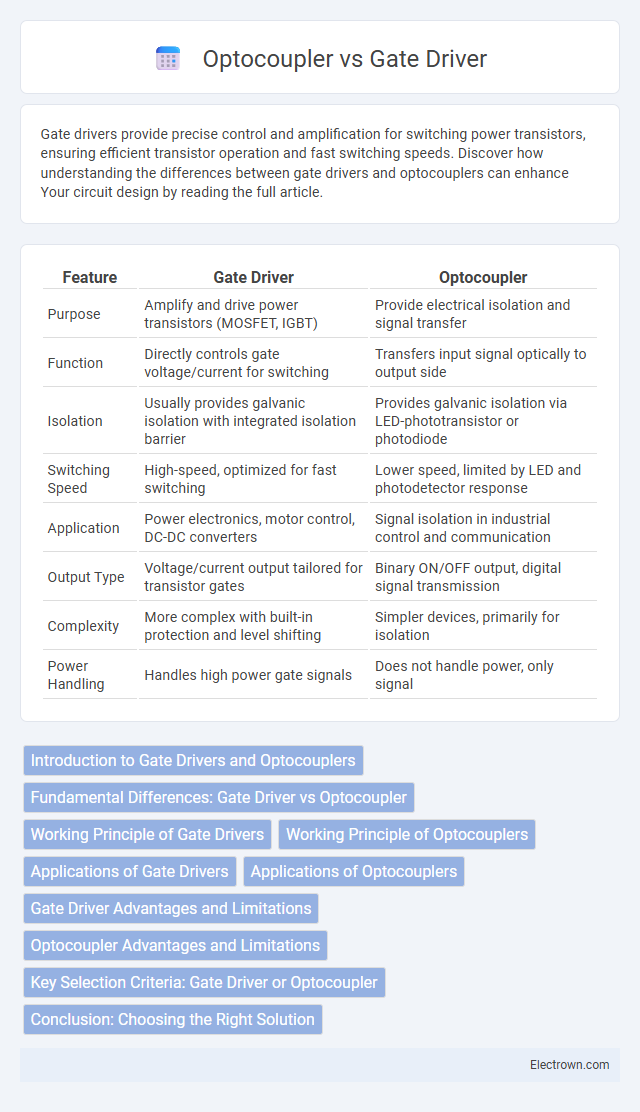Gate drivers provide precise control and amplification for switching power transistors, ensuring efficient transistor operation and fast switching speeds. Discover how understanding the differences between gate drivers and optocouplers can enhance Your circuit design by reading the full article.
Table of Comparison
| Feature | Gate Driver | Optocoupler |
|---|---|---|
| Purpose | Amplify and drive power transistors (MOSFET, IGBT) | Provide electrical isolation and signal transfer |
| Function | Directly controls gate voltage/current for switching | Transfers input signal optically to output side |
| Isolation | Usually provides galvanic isolation with integrated isolation barrier | Provides galvanic isolation via LED-phototransistor or photodiode |
| Switching Speed | High-speed, optimized for fast switching | Lower speed, limited by LED and photodetector response |
| Application | Power electronics, motor control, DC-DC converters | Signal isolation in industrial control and communication |
| Output Type | Voltage/current output tailored for transistor gates | Binary ON/OFF output, digital signal transmission |
| Complexity | More complex with built-in protection and level shifting | Simpler devices, primarily for isolation |
| Power Handling | Handles high power gate signals | Does not handle power, only signal |
Introduction to Gate Drivers and Optocouplers
Gate drivers are specialized circuits designed to efficiently control power transistors such as MOSFETs and IGBTs by providing the required gate voltage and current to switch these devices rapidly and reliably. Optocouplers, on the other hand, enable electrical isolation between different circuit sections by transmitting signals via light, protecting sensitive components from high voltages and noise. Understanding the functional roles and application environments of gate drivers versus optocouplers is essential for optimizing power electronics performance and ensuring system safety.
Fundamental Differences: Gate Driver vs Optocoupler
Gate drivers and optocouplers serve distinct functions in electronic circuits; gate drivers provide the necessary voltage and current to efficiently switch power transistors like MOSFETs and IGBTs, ensuring fast and controlled switching performance. Optocouplers perform electrical isolation by transferring signals via light between circuits, protecting low-voltage control systems from high-voltage power stages. Unlike optocouplers that focus on isolation and signal integrity, gate drivers focus on power transistor activation and drive strength, making each component essential for different aspects of power electronics design.
Working Principle of Gate Drivers
Gate drivers operate by amplifying low-power control signals to efficiently switch high-power transistors like MOSFETs or IGBTs, ensuring fast and precise gate charging and discharging. Unlike optocouplers, which use light to isolate control and power circuits, gate drivers directly interface with transistor gates for rapid switching with minimal delay. Your choice in switching applications depends on the required speed and isolation, making gate drivers essential for high-frequency, high-current power control.
Working Principle of Optocouplers
Optocouplers operate by transmitting electrical signals through light, using an LED paired with a photodetector to achieve galvanic isolation between input and output circuits. When the input LED is energized, it emits infrared light detected by the photodetector, converting the light signal back into an electrical signal without direct electrical connection. This isolation minimizes electrical noise and protects sensitive components in gate driver circuits by preventing high voltages from affecting the control side.
Applications of Gate Drivers
Gate drivers are essential components in power electronics, used to efficiently switch high voltage transistors like MOSFETs and IGBTs in applications such as motor control, DC-DC converters, and inverters. They provide precise voltage and current necessary to rapidly turn devices on and off, improving switching speed and minimizing power loss in renewable energy systems, electric vehicles, and industrial automation. Unlike optocouplers, gate drivers directly interface with power devices, enabling high-frequency operation and robust performance in power management circuits.
Applications of Optocouplers
Optocouplers are widely used in applications requiring electrical isolation and noise reduction, such as in switching power supplies, microcontroller input protection, and signal isolation in industrial automation systems. Their ability to transmit signals across different voltage domains without direct electrical connection makes them essential in medical devices, telecommunications, and motor control circuits. Your designs benefit from optocouplers when isolating sensitive components from high-voltage spikes or ground loops, enhancing safety and signal integrity.
Gate Driver Advantages and Limitations
Gate drivers offer precise control of power transistors with high switching speeds and strong drive capability, enabling efficient energy conversion in applications such as motor drives and power supplies. They provide galvanic isolation, low propagation delay, and reduced electromagnetic interference compared to optocouplers. Limitations include susceptibility to voltage spikes and the need for complex circuitry to handle high voltage levels, which may increase overall system cost and design complexity.
Optocoupler Advantages and Limitations
Optocouplers provide excellent electrical isolation and noise immunity, making them ideal for preventing high-voltage interference in sensitive circuits. Their compact size and ability to transmit signals across galvanic isolation barriers enhance system safety and reliability. However, optocouplers typically exhibit slower switching speeds and limited bandwidth compared to gate drivers, which can impact performance in high-frequency applications.
Key Selection Criteria: Gate Driver or Optocoupler
Key selection criteria between gate drivers and optocouplers depend on switching speed, isolation requirements, and signal integrity. Gate drivers provide high-speed, efficient drive capabilities directly suited for power transistors, while optocouplers excel in providing galvanic isolation with moderate switching speeds. Designers prioritize gate drivers for high-frequency applications and robust drive strength, whereas optocouplers are chosen when electrical isolation and noise immunity are critical.
Conclusion: Choosing the Right Solution
Gate drivers provide fast, efficient switching with precise voltage and current control for power transistors, making them ideal for high-frequency, high-power applications. Optocouplers offer galvanic isolation and noise immunity, which is crucial when electrical separation between control and power circuits is needed to protect your system. Your choice depends on whether isolation or switching performance is the primary requirement for your design.
Gate driver vs Optocoupler Infographic

 electrown.com
electrown.com